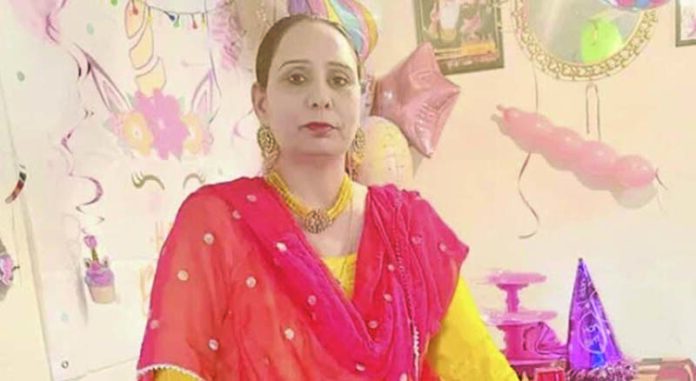That’s why many Punjabi girls are now scared to marry in their own community


BRAMPTON: Davinder Kaur, 43, a mother of four children, was stabbed to death in a Brampton park on June 2 by her estranged husband, showing that violence against women continues unabated in the Punjabi community.
As a social worker, I have been involved in the community for the last 33 years, and every year across Canada, Punjabi women are killed at the hands of the men they know.
Punjabi culture is anti-women, but the community is denial. Female infanticide is still prevalent in our culture.
In our mysogynistic culture, men think they own their women. So they think: How can a woman go their wishes? How can she dare to divorce them? If she does, they says: I will fix you now.
Look at this man who killed Davinder Kaur. While stabbing her, he is making the video and telling her: “Hun call kar police nu, main tenu keha see ke tun naa kar.”
Our Punjabi communtiy here is full of such men whose thinking remains that of a rustic in Punjab. Because of these men, every fourth Punjabi woman here is an abused women. I know Punjabi girls who are scared to get married in our community.
The saddest part is that even Punjabi boys born here carry this dark mentality.
From my experience, I have identified a few reasons for the kind of violence – known as intimate partner violence (IPV) – Davinder Kaur and so many other women have been subjected to:
1. Power and Control: One of the primary reasons behind IPV is the desire for power and control over the victim. The perpetrator may feel threatened by the victim’s independence, assertiveness, or attempts to leave the relationship. They may resort to violence to maintain dominance and control over the victim. Power and control primarily come from misogyny, which means that “certain men have hatred of, contempt for, or prejudice against women. It is a form of sexism that is used to keep women at a lower social status than men, thus maintaining the social roles of patriarchy. Misogyny has been widely practiced for thousands of years”.
2. Jealousy and Possessiveness: Feelings of jealousy, possessiveness, and insecurity can contribute to violent behavior. The perpetrator may believe that
their partner is being unfaithful or is interested in someone else, leading to acts of violence as a response to these perceived threats.
3. Entitlement and Ownership: Some perpetrators view their partners as possessions and believe they have the right to control their lives and make decisions for them. When the victim challenges this perception or attempts to assert autonomy, it can trigger violent reactions.
4. Escalation of Conflict: In some cases, violence can arise as a result of escalating conflicts within the relationship. Factors such as unresolved anger, poor communication, or an inability to manage conflict effectively can lead to a buildup of tension that culminates in violence.
5. Substance Abuse: The use of drugs or alcohol can exacerbate violent tendencies and impair judgement, leading to an increased likelihood of aggressive behavior. While substance abuse does not excuse violence, it can contribute to its occurrence in certain cases.
6. Learned Behavior: Some individuals who perpetrate violence may have grown up in environments where they witnessed or experienced abuse. They may have learned that violence is an acceptable way to handle conflicts or assert control within relationships. This learned behavior can contribute to a cycle of violence that continues across generations.
7. Societal Norms and Gender Expectations: Societal norms and expectations surrounding gender roles can also play a role in IPV. Traditional gender stereotypes that reinforce male dominance and female submissiveness can create a power imbalance within relationships. When these expectations are challenged or not met, it can lead to a violent response from the perpetrator.
8. Mental Health Issues: In some cases, mental health problems, such as personality disorders, anger management issues, or untreated mental illnesses, can contribute to violent behavior within relationships. These conditions can impair an individual’s ability to regulate emotions and make it more difficult for them to resolve conflicts peacefully.
9. Economic Factors: Financial stress, unemployment, or a lack of economic resources can increase tension within a relationship and contribute to the risk of violence. Financial dependence or control can also be used as a means of exerting power and control over the victim.
10. Social Isolation: Perpetrators may isolate their partners from friends, family, and support networks, making it more challenging for victims to seek help or escape the abusive relationship. This isolation can further entrap the victim and escalate the risk of lethal violence.
11. Previous Threats or Non-Fatal Violence: In some cases, prior incidents of threats or non-fatal violence may have occurred within the relationship before it escalated to lethal violence. These warning signs should be taken seriously, as they indicate an increased risk to the victim’s safety.
It’s important to emphasize that these factors do not apply universally to all cases of IPV, and each situation is unique. IPV is a complex issue influenced by a range of personal, societal, and cultural factors.
Understanding and addressing these underlying dynamics is crucial for the prevention and intervention of IPV. Also, it is crucial to approach the issue of IPV from a multidimensional perspective, taking into account individual, relational, societal, and cultural factors. Prevention efforts should focus on challenging harmful gender norms, promoting healthy relationship dynamics, providing support and resources for victims, and holding perpetrators accountable through legal systems and intervention programs.
My recommendation would be that women seek counselling when they are being abused. This would require being brave and overcoming the stigma that ‘I have to disclose my very personal situation to an outsider who is a professional’. But by going to a counsellor, you can understand how dangerous your situation is and what you can do to protect yourself and your children.
Punjabi Community Health Services can be contacted at 905-677-0889 (between 9 a.m. and 5 p.m. Monday–Friday); otherwise, please leave your phone number and a trained counsellor will call you.
You may also send us an email at intake@pchs4u.com.
(Baldev Mutta is the CEO of Punjabi Community Health Services in Brampton)








